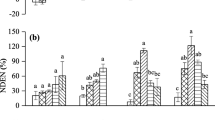Abstract
Ammonia (NH3) emission from poultry houses is a major air quality concern. In poultry litter, uric acid converts to urea which hydrolyzes to NH3, a fraction of NH3 protonates to ammonium (NH4 +). Moisture content (MC), dissociation constant, and Henry's law constant affect NH3 partitioning among solid, liquid, and gas phases. The dissociation constant (Kd) and Henry's Law constant (Kh) that are so well known for dilute aqueous solutions may not apply to broiler litter which has much higher ionic concentration. We quantified Kd, Kh, and NH3 sorption at different MC in broiler litter in replicated lab experiments. Dissociation constant in litter slurry was 1.02 × 10−10, 20 % of the dissociation constant in aqueous solution, which may be due to NH3/NH4 +adsorption and reduced activities of the dissolved ions. Henry's Law constant (0.0158 atm/M) in litter slurry was 4 % lower than Kh in dilute aqueous solution. Ammonia sorption increased linearly with MC from 0 to 55 %, whereas 0 % MC litter adsorbed 5 % of its background total ammoniacal N (TAN) concentration as NH3, litter with 55 sorbed 266 % its background TAN concentration mostly as NH4 +. We have improved the understanding of NH3 sorption in litter as function of MC. However, improved sensors that can measure TAN and pH in unsaturated matrices are required to improve quantification of N fate and transport.




Similar content being viewed by others
References
Arogo, J., Westerman, P. W., & Liang, Z. S. (2003). Comparing ammonium ion dissociation constant in swine anaerobic lagoon liquid and deionized water. Transactions of ASAE, 46, 1415–1419.
Beutier, D., & Renon, H. (1978). Representation of NH3-H2S-H2O, NH3-CO2-H2O, NH3-SO2-H2O vapor–liquid equilibria. Industrial and Engineering Chemistry Process Design and Development, 17(3), 220–230.
Cooper, C. D. and F. C. Alley. 2002. Air pollution control—a design approach. 3rd ed. Waveland Press, Inc.
Dasgupta, P. K., & Dong, S. (1986). Solubility of ammonia in liquid water and generation of trace levels of standard gaseous ammonia. Atmospheric Environment, 20, 565–570.
De Visscher, A., Harper, L. A., Westerman, P. W., Liang, Z., Arogo, J., Sharpe, R. R., & Van Cleemput, O. (2002). Ammonia emissions from anaerobic swine lagoons: model development. Journal of Applied Meteorology, 41, 426–433.
Edwards, T. J., Maurer, G., Newman, J., & Prausnitz, J. M. (1978). Vapor–liquid equilibria in multicomponent aqueous solutions of volatile weak electrolytes. AIChE Journal, 24, 966–976.
Edwards, T. J., Newman, J., & Prausnitz, J. M. (1975). Thermodynamics of aqueous solutions containing volatile weak electrolytes. AICHE Journal, 21(2), 248–259.
Hashimoto, A. G. and D. C. Ludington. 1971. Ammonia desorption from concentrated chicken manure slurries. In Livestock Waste Management: Proc. International Symposium on Livestock Wastes, 117–121. St. Joseph, Mich.: ASAE.
Jayaweera, G. R., & Mikkelsen, D. S. (1990). Ammonia volatilization from flooded soil systems: a computer model. I. Theoretical aspects. Soil Science Society of America Journal, 54, 1447–1455.
Kangas, L., & Sanna, S. (2001). Regional nitrogen deposition model for integrated assessment of acidification and eutrophication. Atmospheric Environment, 36, 1111–1122.
Kithome, M., Paul, J. W., & Kannangara, T. (1999). Adsorption isotherms of ammonium on coir. Communications in Soil Science and Plant Analysis, 30, 83–95.
Liang, W. 2011. Mechanisms controlling ammonia/um dynamics in broiler litter. MS thesis. Raleigh, North Carolina State University
Liu, Z., Wang, L., Beasley, D. B., & Shah, S. B. (2009). Modeling ammonia emissions from broiler litter at laboratory scale. Transactions of the ASABE, 52, 1683–1694.
NCSU (2013). Animal and Poultry Manure Production and Characterization, Table 61, Broiler House Whole Litter Characteristics. Available at: http://www.bae.ncsu.edu/topic/animal-waste-mgmt/program/land-ap/barker/a&pmp&c/brl.htm. Accessed 22 Nov 2013.
Olesen, J. E., & Sommer, S. G. (1993). Modeling effects of wind speed and surface cover on ammonia volatilization from stored pig slurry. Atmospheric Environment, 27, 2567–2574.
Ong, S. E., & Lion, L. W. (1991). Mechanisms of tricholoroethylene vapor sorption onto soil minerals. Journal of Environmental Quality, 20, 180–188.
Pagans, E., Font, X., & Sanchez, A. (2007). Adsorption, absorption, and biological degradation of ammonia in different biofilter organic media. Biotechnology and Bioengineering, 97, 515–525.
Prasad, B., & Sinha, M. K. (1981). Physical and chemical characterization of soil and poultry litter humic and fulvic metal complexes. Plant and Soil, 54, 223–232.
Reece, F. N., Lott, B. D., & Deaton, J. W. (1980). Ammonia in the atmosphere during brooding affects performance of broiler chickens. Poultry Science, 59, 486–488.
Snoeyink, V. L. and D. Jenkins. 1982. Water Chemistry, 3rd ed. Wiley.
Sobczyk, D. P., Hesen, J. J. G., van Grondelle, J., Schuringa, D., de Jong, A. M., & van Santen, R. A. (2004). Adsorption assisted desorption of NH3 on ғ-alumina studied with positron emission profiling. Catalysis Letters, 94, 37–43.
Zhang, R. H. (1992). Degradation of swine manure and a computer model for predicting the desorption rate of ammonia from an under-floor pit. PhD diss. Urbana: University of Illinois.
Author information
Authors and Affiliations
Corresponding author
Rights and permissions
About this article
Cite this article
Liang, Wz., Classen, J.J., Shah, S.B. et al. Ammonia Fate and Transport Mechanisms in Broiler Litter. Water Air Soil Pollut 225, 1812 (2014). https://doi.org/10.1007/s11270-013-1812-x
Received:
Accepted:
Published:
DOI: https://doi.org/10.1007/s11270-013-1812-x




